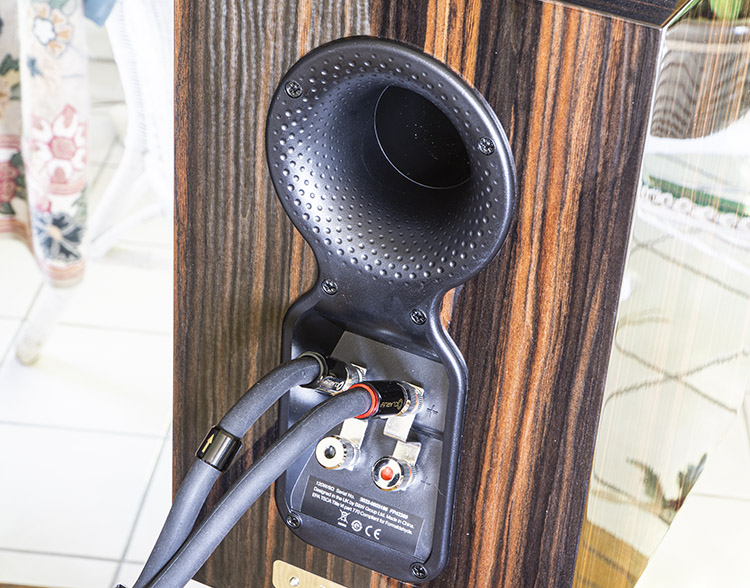Well, people have opinions on that 😀 I'd say waveguide is best if audio performance is to be considered (directivity control, loud enough). Size and looks are against waveguides comparing to direct radiating system and some might prefer wider dispersion spacious sound over precise sound. Both have their ups and downs, good and not so good system designs.
Last edited:
Science it's not an opinion: When you change the shape of the wave by the means of a horn, it is not the original one. This happens in sound reproduction. when using horns for live sound (rock music & a little of jazz) the'flaws' are already incorporated with the sound and are part of it
Thats why some horns sound bad, diffraction and all sorta reflections in the throat and mouth. More recent designs like in the ATH thread show very good performance though. Literally no acoustic anomalies at all extending as low as big waveguide one can tolerate (and get a driver to reproduce), with pretty constant directivity. I'm not sure if everybody understand how remarkable that is. Even if the transducers and crossovers were perfect ruler flat, rest of the performance issues are due to physical dimensions of the sound waves and transducers and enclosures. The waveguides in ATH thread really promise to deliver the sound from electricity to the listening spot like never seen or heard before. This doesn't mean other systems start to sound bad, but it is the best thing yet.
Last edited:
Yes, there are a few aspects to it, my present views (these may change!) to your very valid points.
Cost, no getting around this, it's a perceived cost/benefit thing, but possibly less need for complex stiffening internally.
Less bass volume, absolutely, hence the isobarik drivers. But also less interaction on the other drivers due to removal of back wave.
There is space inside the mid box for the crossover.
Cost, no getting around this, it's a perceived cost/benefit thing, but possibly less need for complex stiffening internally.
Less bass volume, absolutely, hence the isobarik drivers. But also less interaction on the other drivers due to removal of back wave.
There is space inside the mid box for the crossover.
The only way to isolate drivers is to use an elastic suspension, being it air sping or rubber band cords.It works when the 'elastic arrow' gets balanced by the k of the spring and the weight of the thingy to be suspended. Each driver is isolated by the others by the means of the springs.
In order, the things that produce more vibrations is 1) subwoofer;2)woofer;3)midrange
SO the tweeter and the midrange need to be separated from the woofer
Yes, this is all true, but, again, there are levels, as with turntable isolation. I have found that magnetic levitation is best but simple triangular erasures give a good improvement. One good idea I had seen was suspending the boxes from monofilament (fishing line) suspended from an external frame. (Though it was a bit ugly). At the end of the day I'm looking for a realistic option that gives a tangible improvement.
Wondering if when we were to record an electric bass guitar and play it back through a bass shaker mounted on the f-bridge of a contrabass, would it still sound like an electric bass guitar?
Why are some open baffle speakers shaped like a torso?
Opening lunchbox too see what's inside
Why are some open baffle speakers shaped like a torso?
Opening lunchbox too see what's inside
"Why are some open baffle speakers shaped like a torso?"
I hope there're not shaped like mine !
At the end of the day, it sounds obvious, but I just want out of the speaker what was put in as a signal. This means removing spurious artefacts as much as it practical
I hope there're not shaped like mine !
At the end of the day, it sounds obvious, but I just want out of the speaker what was put in as a signal. This means removing spurious artefacts as much as it practical
Last edited:
Science it's not an opinion: When you change the shape of the wave by the means of a horn, it is not the original one. This happens in sound reproduction. when using horns for live sound (rock music & a little of jazz) the'flaws' are already incorporated with the sound and are part of it
So, what is better than a horn, which horn and which shape of soundwave are you talking about?
Cabinet shape etc. can have quite the influence on polar results. In my personal project I wanted to reduce the influence of diffraction and chose to use fluent shapes to avoid as much diffraction as I could.
In collaboration with member fluid, we decided to test the shape I came up with using simulation tools like ABEC. We compared the shape I ended up using in my arrays to a flush mounted driver with the same egg shaped outside enclosure and a more traditional boxed/rectangular shape (with small roundover added).
Let's see that story in pictures, starting with the simple box:
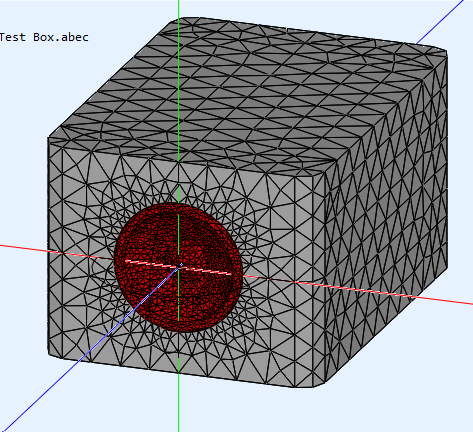
It's horizontal polars:
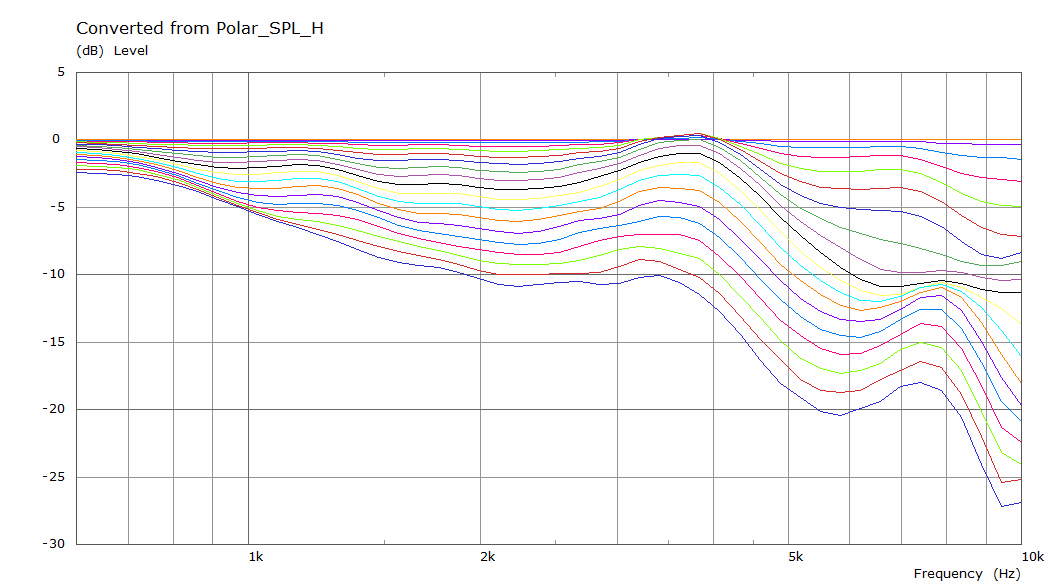
On to a more complex 'egg shape' box:
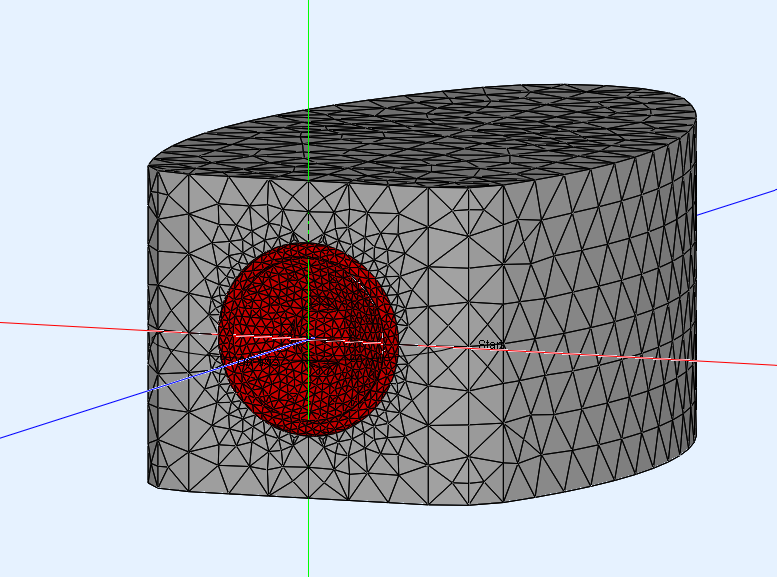
It's horizontal polars:
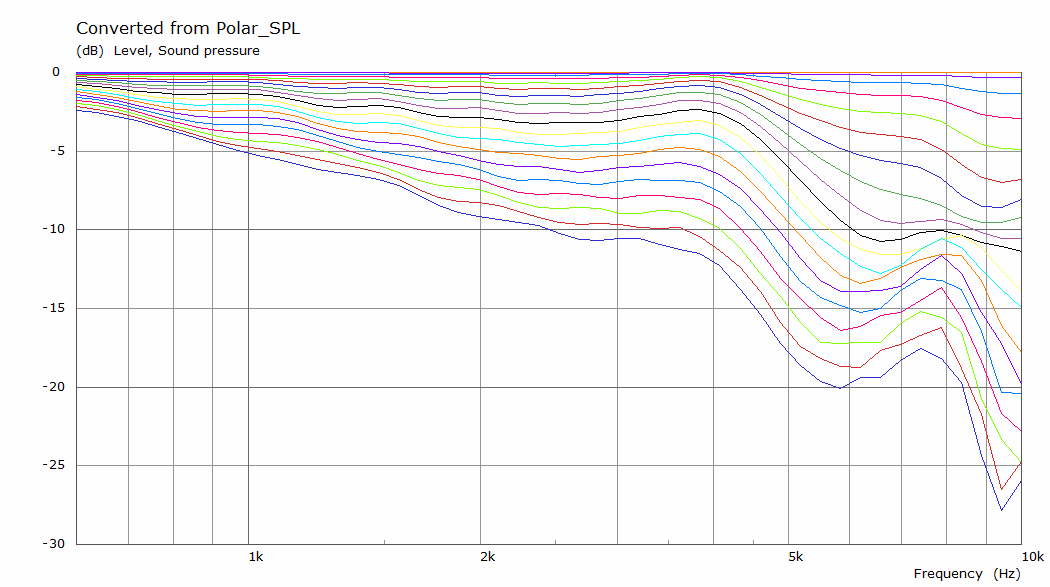
And finally a back-mounted driver in the 'egg shape':
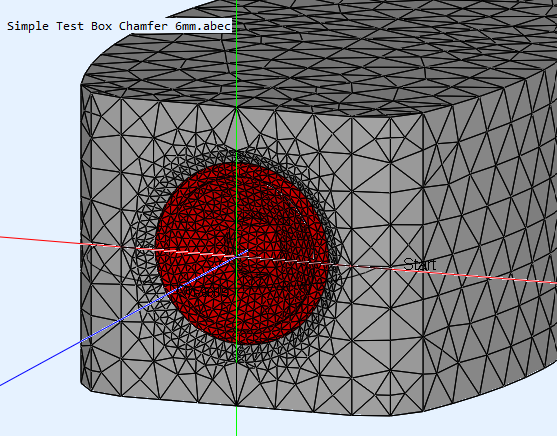
It's horizontal polars:
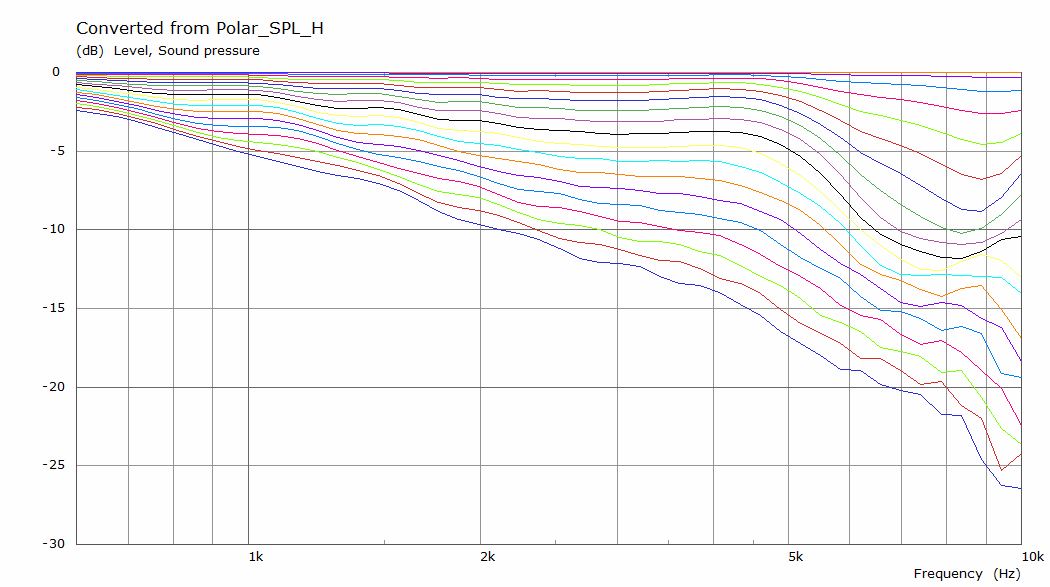
You see each step here, having influence on the polar results. Even the outside enclosure shape having some influence on the final end result with the back mounted driver.
In a way it is a horn folded backwards...
Worth it? To me it is 😀. That last shape is what I went with, long ago, so you'll hear no complaints from me. But it might give some of you a bit of inspiration.
Not aimed at anyone in particular and no pun intended.
Here's the start of the ABEC simulations on my thread: https://www.diyaudio.com/forums/full-range/242171-towers-25-driver-range-line-array-663.html#post6524791
In collaboration with member fluid, we decided to test the shape I came up with using simulation tools like ABEC. We compared the shape I ended up using in my arrays to a flush mounted driver with the same egg shaped outside enclosure and a more traditional boxed/rectangular shape (with small roundover added).
Let's see that story in pictures, starting with the simple box:
It's horizontal polars:
On to a more complex 'egg shape' box:
It's horizontal polars:
And finally a back-mounted driver in the 'egg shape':
It's horizontal polars:
You see each step here, having influence on the polar results. Even the outside enclosure shape having some influence on the final end result with the back mounted driver.
In a way it is a horn folded backwards...
Worth it? To me it is 😀. That last shape is what I went with, long ago, so you'll hear no complaints from me. But it might give some of you a bit of inspiration.
Not aimed at anyone in particular and no pun intended.
Here's the start of the ABEC simulations on my thread: https://www.diyaudio.com/forums/full-range/242171-towers-25-driver-range-line-array-663.html#post6524791
Last edited:
Thanks Wesayso, for that fantastic information. Would I be wrong in saying that eventually you used a rounded inner edge, a small "throat" so to speak? This seems to have made for a more even soundwave output from a polar standpoint. Would in effect this be acting as a very small waveguide? When using this inner radius is the outer one as important?
Regards R
Regards R
Indeed, the round-over is acting as a small waveguide, I do believe every detail could matter, if I judge what even tiny modifications of the shape of a horn can do as demonstrated multiple times in the ATH waveguide thread. So I cannot give a valid prediction of a change like that.
** Though by far, the tiny waveguide is responsible for the biggest positive change **
** Though by far, the tiny waveguide is responsible for the biggest positive change **
Last edited:
Totally, great effort can make great loudspeaker.
It has been fun to realize that most diffraction problems plague the mid frequencies. Very relevant to the thread topic. For example if comparing two commercial speakers and if the other has better sounding midrange than the other it is easy to think the midrange driver is better when it could actually be due to different baffle diffraction. Or other system design related difference.
It has been fun to realize that most diffraction problems plague the mid frequencies. Very relevant to the thread topic. For example if comparing two commercial speakers and if the other has better sounding midrange than the other it is easy to think the midrange driver is better when it could actually be due to different baffle diffraction. Or other system design related difference.
"** Though by far, the tiny waveguide is responsible for the biggest positive change **"
That's really interesting, thanks. It's back to the drawing board for me then!
That's really interesting, thanks. It's back to the drawing board for me then!
shale gas thread...
mamamia... I have been beginning to use a router for 2 months, but now loudspeakers diy sport seems more and more CNC designed thingies... which can be as expensive when made for two pieces as a new expensive loudspeaker... well, nothing wrong with that, there is no limit in a hobby but the laws and the wallet difraction resistance.
But so beautifull, bravo Wesayso...
mamamia... I have been beginning to use a router for 2 months, but now loudspeakers diy sport seems more and more CNC designed thingies... which can be as expensive when made for two pieces as a new expensive loudspeaker... well, nothing wrong with that, there is no limit in a hobby but the laws and the wallet difraction resistance.
But so beautifull, bravo Wesayso...
- Home
- Loudspeakers
- Multi-Way
- World's Best Midranges - Shocking Results & Conclusions.
